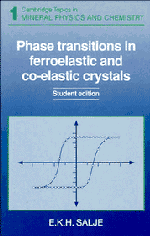Book contents
- Frontmatter
- Contents
- Errata
- Preface
- A brief guide for the reader
- 1 Introduction and some definitions
- 2 Ferroelastic and co-elastic phase transition
- 3 The Landau potential
- 4 The spontaneous strain
- 5 Coupling between the spontaneous strain and the order parameter
- 6 Macroscopic classification of ferroic and co-elastic crystals
- 7 Ferroelastic and co-elastic twin structures
- 8 Domain mobilities and elastic instabilities in ferroelastic and co-elastic materials
- 9 Specific heat anomalies and the excess entropy
- 10 Coupling between order parameters in ferroelastic and co-elastic crystals
- 11 Gradient coupling and strain modulations
- 12 Some aspects of the kinetic behaviour of ferroelastic and co-elastic crystals: an outlook
- References
- Appendix: An atomistic model for the Landau potential and the origins of the saturation effect
- Index
10 - Coupling between order parameters in ferroelastic and co-elastic crystals
Published online by Cambridge University Press: 03 May 2011
- Frontmatter
- Contents
- Errata
- Preface
- A brief guide for the reader
- 1 Introduction and some definitions
- 2 Ferroelastic and co-elastic phase transition
- 3 The Landau potential
- 4 The spontaneous strain
- 5 Coupling between the spontaneous strain and the order parameter
- 6 Macroscopic classification of ferroic and co-elastic crystals
- 7 Ferroelastic and co-elastic twin structures
- 8 Domain mobilities and elastic instabilities in ferroelastic and co-elastic materials
- 9 Specific heat anomalies and the excess entropy
- 10 Coupling between order parameters in ferroelastic and co-elastic crystals
- 11 Gradient coupling and strain modulations
- 12 Some aspects of the kinetic behaviour of ferroelastic and co-elastic crystals: an outlook
- References
- Appendix: An atomistic model for the Landau potential and the origins of the saturation effect
- Index
Summary
Ferroelastic and co-elastic crystals often undergo cascades of phase transitions with several interacting order parameters. Their interaction is the origin of ‘cross-over’ behaviour, and may also stabilise phases which can only exist if several order parameters couple. A descriptive introduction leads to a quantitative formulation of general cases which the reader might like to use for his or her own research work.
We have seen in Chapter 5 how the physical mechanism of ferroelastic and co-elastic phase transitions can be described by order parameters. These order parameters couple with the spontaneous strain and thereby lead to the excess lattice distortions which are an essential feature of co-elastic materials. The order parameters were treated in most examples as one-dimensional quantities, the only exception so far was the cubic-tetragonal transition discussed in Chapter 8 where the order parameter had two competing components, and we shall come back to the question of multi-dimensional order parameters in an example below. First we wish to concentrate on another aspect of interacting order parameters which is rather crucial to the understanding of the behaviour of crystals with complex structures - an effect only discovered and appreciated over the last decade or so.
It is an empirical observation that phase transitions in minerals and other materials are often driven simultaneously by more than one physical mechanism.
- Type
- Chapter
- Information
- Phase Transitions in Ferroelastic and Co-elastic Crystals , pp. 147 - 163Publisher: Cambridge University PressPrint publication year: 1991

